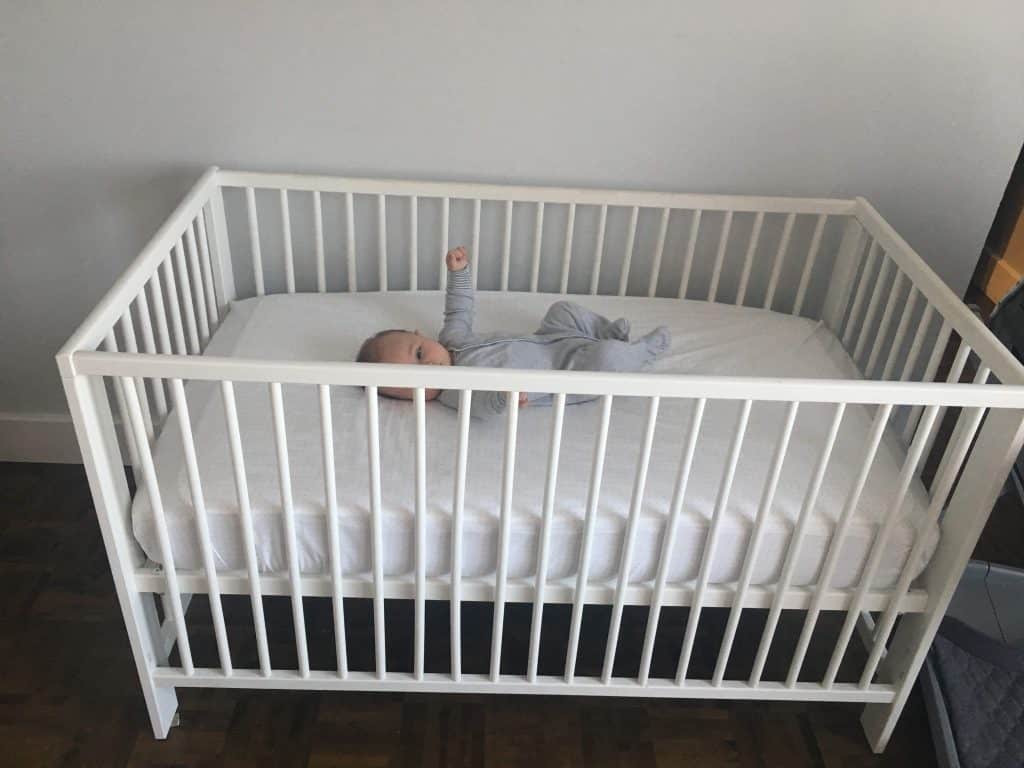A recent study on the causes of infant deaths show that approximately 3500 infants die each year due to sleep-related causes. Deciding where your baby will sleep is one key question every parent should be asking themselves.
With these alarming statistics, it is normal for every parent to be worried and want to practice safe sleeping habits for their newborn baby.
Even after preparing your baby nursery and buying all the essential baby gear, you’ll often find yourself asking the following questions: Where will my baby sleep? Will they go straight to their crib or will I first place them in a bassinet? How long should they stay in my room?
According to the Centers for Disease Control and Prevention and the American Academy of Pediatrics, parents should sleep in the same room with their newborn for at least 6 months and up to their first year of life. This practice has been shown to reduce the risk of sudden infant death syndrome (SIDS) by up to 50%.
We’ll look at other safety measures for creating a safe sleeping area for your babies later in the article. But let’s start with finding the answer to our main question: Can a newborn sleep in a crib?
Can You Put A Newborn In A Crib?
The simplest and most straightforward answer to this question is yes you can. But there are many other safety aspects that should be considered before making this decision.
Is your crib and mattress safe for a newborn? Can you fit the crib in your bedroom? How long do you plan on room-sharing? Should you move the crib from the nursery to your room or get a secondary sleeping device such as a bassinet, portable crib, mini crib or even a second full-size crib? There are so many questions but the right answer will be specific to your situation.
To determine whether a baby crib is the best option for your newborn baby, you’ll need to consider some of the factors below.
The size of your bedroom
Perhaps your baby’s nursery is already setup. But as stated earlier, it is recommended that you share the same bedroom with your newborn until their first birthday.
Parents are highly advised against sharing the same bed or sleeping surface, with their infants since this has been proven to increase the risk of SIDS. Your baby should have their own sleeping space.
If you want to place your newborn in their crib, this means that you ought to have enough space in your bedroom enough for your baby’s crib. And you must be willing to move the crib from the nursery to your room.
Remember a baby crib is fairly large. It will require a lot of space. Is your bedroom big enough? Will your baby crib fit in your bedroom?
If you’ve answered yes to the above questions, then a baby crib can be a great option for you. However, if your bedroom is not big enough, you can consider other sleep areas such as a bassinet or a mini crib. These require smaller space.
Your Budget
With so many baby accessories to shop for, your pockets may run dry quickly. For this reason, some parents may want to choose the most cost-effective solution for their baby’s sleep needs.
In such a case, a baby crib would be the most viable solution. It is large enough for your baby to grow into. Also, baby cribs are strong and well-made to withstand mishandling, jumping, and tossing by toddlers.
However, if you have the budget for it, it is highly recommended that your baby sleeps in a bassinet after which they can move to their baby crib.
A bassinet is a small crib that provides a snug and cozy space for your baby to sleep. They take up a very little space and can be placed beside your bed which is very convenient for those late-night feedings.
In addition, some bassinets come with wheels that make it easier to move around with your baby. Those bassinets that do not have wheels usually have a handle and can be carried easily from one place to the other.
But regardless of where you place your newborn to sleep, here are several safe sleep tips for babies. They’ll help to prevent SIDS.
What did we do? Pro Tip
We wanted to room-share with our son for at least 6 months so like good and loving parents, we went out and spent money on a bassinet. The only issue was that we chose a very small bassinet and our baby outgrew it in less than 3 months…
At this point we were tired of spending money and weren’t sure what to do. He already had a crib but it was in the nursery, it matched all the other furniture in the baby room and it was a pain to disassemble in order to move to our room and the have to re-assemble it again.
So, we looked on Craigslist and found a $35, lightly used Ikea crib WITH a mattress! Score!

Luckily, we have a large enough room so we were able to put the crib in there and that’s where baby slept until we were comfortable moving him to his big boy room.
Tips for safe sleep
- Always put your baby to sleep on their back. Avoid placing them to sleep on their stomachs or their side as this increases the risk of SIDS.
- The baby’s sleeping area should be bare. Remove any soft bedding, toys, or other blankets from the crib.
- Your choice of a crib, play yard, pack n play, or bassinet should adhere to all the current safety guidelines given by the Consumer Product Safety Commission (CPSC).
- Avoid overheating your baby. Instead of covering your baby with blankets, opt for sleeping sacs or swaddle which are safer and cozier.
- Try as much as possible to minimize the time your baby spends in their car seat or other devices that are not approved for sleep such as bouncers and swings.
- Do not worry in case your baby dozes off in their swing, sling or stroller. The short time spent on these will have no adverse effects. But, prolonged use is not advised.
- Ensure the baby crib, bassinet, or playpen is assembled properly. If they are not assembled properly, your baby is at risk of being hurt should they collapse with the baby in it.
- Ensure the crib mattress fits snugly without leaving space between the mattress and the crib. It is recommended that the mattress should be thick and hard, which is safer for your baby.
- In case you use a bassinet ensure that it has a wide and stable base that will not topple over with the slightest movement.
- Do NOT use pillows and crib bumpers as they increase the risk of strangulation and suffocation for infants.
In Conclusion
As you have seen above, it is 100% safe for a newborn to sleep in a crib. You’ll only need to ensure that you follow all the safety tips outlined above and at the AAP safe sleep guidelines.
Even though cribs are safe for newborns, using a bassinet may be the most convenient option during your baby’s first few months. This is because bassinets are easily portable, snug, and they’ll take up a very little space in your bedroom.
Where do you prefer to place your newborn to sleep? Tell us in the comment section below.
Paul is a passionate dad who founded Upside Dad to share his parenting journey with other new parents. He graduated from Concordia University and worked as a test engineer for over a decade. Paul loves dad jokes and craft beer.
Learn more about Paul and Upside Dad here.
